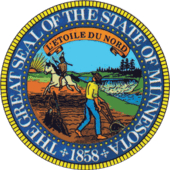William Rush Merriam
| William Rush Merriam | |
|---|---|
|
William Rush Merriam | |
| 11th Governor of Minnesota | |
|
In office January 9, 1889 – January 4, 1893 | |
| Lieutenant |
Albert E. Rice Gideon S. Ives |
| Preceded by | Andrew Ryan McGill |
| Succeeded by | Knute Nelson |
| 18th Speaker of the Minnesota House of Representatives | |
|
In office 1887–1889 | |
| Preceded by | John L. Gibbs |
| Succeeded by | Charles H. Graves |
| Personal details | |
| Born |
July 26, 1849 Wadham's Mills, New York, U.S. |
| Died |
February 18, 1931 (aged 81) Port Sewall, Florida, U.S. |
| Political party | Republican |
| Spouse(s) | Laura Hancock |
| Profession | banker |
| Religion | Episcopalian |
William Rush Merriam (July 26, 1849 – February 18, 1931) was an American politician. The son of Minnesota House Speaker John L. Merriam, he served in the Minnesota House of Representatives in 1883 and 1887 and was the Speaker of the House in 1887. He served as the 11th Governor of Minnesota from January 9, 1889 to January 4, 1893. He was a Republican.
By 1888 a split in the state Republican Party was reflected in an unorthodox selection of a gubernatorial candidate. Instead of supporting the reform-minded incumbent, Andrew Ryan McGill, a majority of party stalwarts rallied behind William Merriam, an ambitious St. Paul banker and speaker of the Minnesota House of Representatives.
Merriam's re-election campaign two years later was affected by another, more widespread phenomenon, the Farmers' Alliance. This third party of disaffected Republicans and Democrats was dedicated to promoting the commercial and social interests of agrarian America. Merriam defeated the Alliance candidate in 1890, but the upstart party significantly eroded his plurality.

As governor, Merriam was a thrifty executive who was more interested in limiting spending than in legislative reform. The most notable legacy of his administration was the adoption of the Australian ballot, which allowed citizens to vote in comparative privacy. In his private life, the sociable Merriam was keen on sports, owned horses, and was said to possess "good nature, gracious manners, and an attractive personality."
Merriam's final accomplishment was appropriate for a banker and businessman who could work well with both people and numbers. He was director of the twelfth national census and later persuaded Congress to establish a permanent Census Bureau, where he served as its first director. Merriam never returned to Minnesota, but retired instead to Florida, where he died in Port Sewall[1] at age 81.
His three-quarter portrait by the Swiss born American artist Adolfo Müller-Ury (1862–1947) was painted in 1892. This and a portrait of his wife were exhibited in St. Paul in that year. A small, bust-length portrait, is now in the collection of the Newport Preservation Society, Rhode Island; it was formerly in the collections of Jessica Dragonette and the University of Wyoming. Müller-Ury is also known to have painted a portrait of their son Amherst Merriam as a baby.
References
- ↑ Obituary,The Washington Post, Washington, D.C., 20 Feb 1931. Port Sewall is a populated place in Martin County south of Stuart, Florida.
External links
- Biographical information and his gubernatorial records are available for research use at the Minnesota Historical Society.
- Minnesota Legislators Past and Present
| Political offices | ||
|---|---|---|
| Preceded by John L. Gibbs |
Speaker of the Minnesota House of Representatives 1887–1889 |
Succeeded by Charles H. Graves |
| Preceded by Andrew Ryan McGill |
Governor of Minnesota 1889–1893 |
Succeeded by Knute Nelson |
| Preceded by Carroll D. Wright |
Director of the United States Census Bureau 1899–1903 |
Succeeded by Simon Newton Dexter North |


